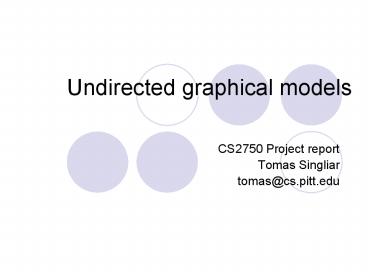Undirected graphical models - PowerPoint PPT Presentation
1 / 13
Title:
Undirected graphical models
Description:
Rock. Lime. Drink. Graphical models NLP example 'Split' the nodes according to semantics 'The Rolling Stones spokesman agreed that the rock stars prefer beer to ... – PowerPoint PPT presentation
Number of Views:79
Avg rating:3.0/5.0
Title: Undirected graphical models
1
Undirected graphical models
- CS2750 Project report
- Tomas Singliar
- tomas_at_cs.pitt.edu
2
Outline
- Graphical models
- directed and undirected models
- Representation and problems
- Boltzmann machines
- Inference
- Monte Carlo methods
- Variational methods (mean-field)
- Loopy belief propagation
- Learning
- Applications
3
Graphical models NLP example
- We want to represent how words appear together in
text - Lots of ambiguity involved
- Would be difficult to represent with a directed
model
4
Graphical models NLP example
- Split the nodes according to semantics
- The Rolling Stones spokesman agreed that the
rock stars prefer beer to lime juice. - Disambiguation of lime take the node that
achieves the higher probability
5
Representation
- Markov condition
- Each node is independent of all other given its
- neighbors (the Markov blanket)
- The joint probability is expressed as product of
local potentials
6
Boltzmann machines
- Graph of stochastic units, take on values 0, 1
- Always includes hidden units
- Potentials are pairwise defined weights wij and
bias weights hi - Energy (optimized in Metropolis-Hastings or
simulated annealing) - Gibbs distribution low energy high
probability - Update rule - stochastic
7
Inference
- Inference task given evidence nodes E, compute
- Boltzmann machine MC method
- Gibbs sampler
- Choose i so that every i appears often enough
- sample from
- converges to true distribution under condition of
positivity - Variational methods
- choose approximating distribution
- e.g. all independent (mean-field)
- minimize KL divergence KL(PQ)
8
Inference Boltzmann machine mean field
- assume product of independent Bernoulli
distributions - minimize KL divergence
- compute derivatives w.r.t. ?i and set equal to 0
- we get sigma-shaped fixpoint equations
9
Inference
- Variational methods
- mean field all nodes disconnected
- can be imprecise
- allow more edges, e.g. acyclic graphs are easy
junction tree - cluster trade speed for precision
- Loopy belief propagation
- Belief propagation applied to loopy graphs
- Not guaranteed to converge
- Works out well for some graphs in practice
- If converges, then to Bethe/Kikuchi free energy
minima
10
Learning - MCMC
- Monte Carlo methods
- Boltzmann machines
- clamp evidence nodes
- run network (minimize energy, Metropolis
algorithm) - increment weights where both on capture
dependencies - release evidence nodes
- run network
- decrement where both on remove spurious
correlations - loop
- comes from minimizing KL-divergence between free
and clamped
11
Learning - IPF
- by maximizing data likelihood we get the
condition - model marginals equal empirical marginals
- IPF goes after that rescale potentials so that
the above holds - yields iterative equation
- performs log-likelihood ascent in coordinates fC
- can also be derived by minimizing KL
12
Applications
- Magnetic properties material physics
- Probabilistic image modeling
- Image transferred trough noisy channel
- MRF encodes channel noise properties
- Restored image MAP estimate of image before
noise - Natural language processing
- word/lexeme distribution in corpus
- Network reliability analysis
- percolation phenomena
- failure of one component puts other under stress
13
Undirected graphical models































